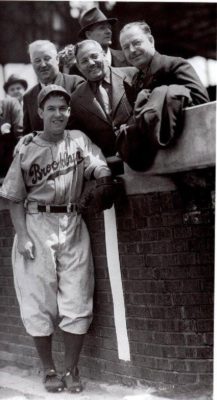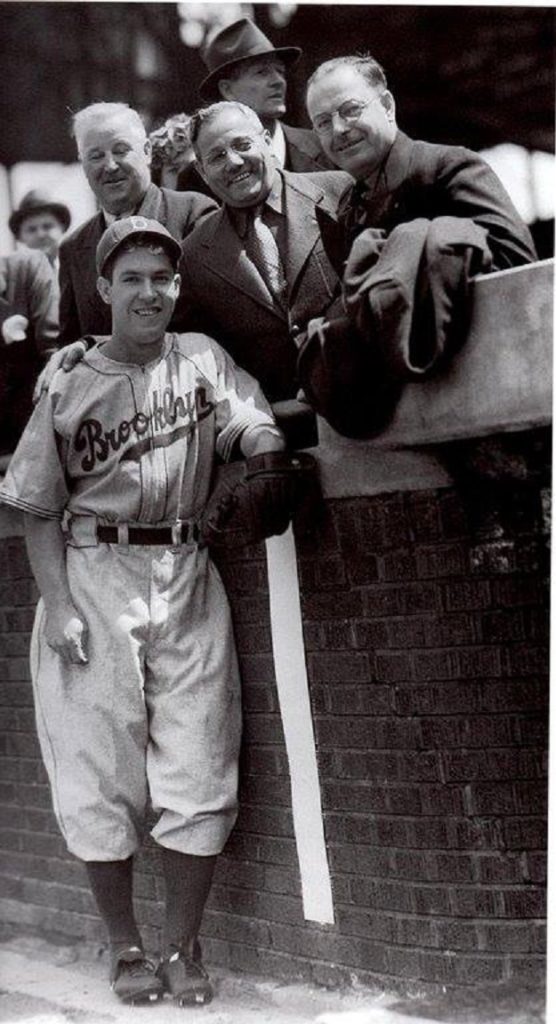“Pistol Pete” Reiser Photo Gallery
Click on any image below to see photos in full size and to start Photo Gallery:

Another Edition of: “Baseball’s Forgotten Stars!”
“There was only one other player comparable to Pete Reiser: Willie Mays. Pete had more power than Willie—left-handed and right-handed both. Willie Mays had everything. Pete Reiser had everything but luck” –Dodger Manager Leo Durocher
That’s quite a statement. We all know Durocher had a tendency to, shall we say, “expand on the truth” a bit, but geez, Leo was a guy who was a teammate of Babe Ruth and was still in the game as late as the 1970s. To say he’d “seen ‘em all” is not an exaggeration. So when he compares Pete Reiser favorably to Willie Mays, we have to at least listen to what he says. But Leo was just getting warmed up in his praise. Check out this passage from his book, “Nice Guys Finish Last”:
“Peter Reiser just might have been the best baseball player I ever saw. He could throw as good as Willie, and he could throw right-handed and left-handed [!]. You think Willie could run? You think Mickey Mantle could run? Name whoever you want and Pete Reiser was faster. And he knew how to run the bases too. In an era when there wasn’t that much stealing, he stole home for me seven times in one year.”
Thanks to our reader Mike O’Leary for suggesting Pete Reiser for this edition of “Baseball’s Forgotten Stars,” who I remember seeing in the 1960s when he was a Cub coach. When I first saw the featured photo above, I thought I was looking at the Dodger’s batboy, or maybe the kid brother of one of the players. But no…It’s “Pistol Pete” Reiser! This little guy is the player Leo had no trouble comparing to the great Willie Mays. Hard to believe! Here’s a little info on Pete Reiser’s career, a great player who was one of the most injury prone players ever to don a major league uniform.
“Pistol Pete” Reiser played 10 seasons in the major leagues (1940-52) for the Dodgers (1940-‘42, 1946-‘48), Braves (1949-50), Pirates (1951), and Indians (1952), losing three years to military service. Pete batted .295 with 58 home runs, 368 RBIs, a .380 on-base percentage, and a .450 slugging average.
In 1941, his first season as a regular starter, Reiser helped the Dodgers win the National League pennant, losing the World Series to the Yankees – a series memorable for the Mickey Owen passed ball. Reiser was a sensation that year, winning the National League batting title (.343), and leading the league in doubles (39), triples (17), runs (117), slugging percentage (.558), OPS+ (164), and total bases (299).
The three-time All-Star is remembered as a player with remarkable talent, but who never reached full potential because of recurring injuries. He led the majors in broken collarbones, dislocated shoulders, and fractured skulls. He was carried off the field a record 11 times. His scariest injury came in 1947, when he crashed into the Ebbets Field center-field fence at a full stride, collapsed, and was carried into the clubhouse, where a priest administered the last rites. Reiser was paralyzed for 10 days, but he recovered to play five more seasons, although he was never the same player.
In 1981, Lawrence Ritter and Donald Honig included Pete Reiser in their book “The 100 Greatest Baseball Players of All Time.” They used what they called “Smoky Joe Wood Syndrome” to explain why a truly exceptional player whose career was curtailed by injury—despite not having had career statistics that would quantitatively rank him with the all-time greats—should nevertheless be included on the list.
Gary Livacari
Photo Credits: Featured photo from the George Brace collection; All others from Google search
Information: Excerpts edited from the Pete Reiser Wikipedia page.
Subscribe to my blog for automatic updates and Free Bonus Reports: “Memorable World Series Moments” and “Gary’s Handy Dandy World Series Reference Guide.”

